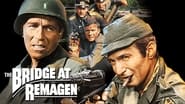chaswe-28402
The impression left at the end of this fictionalized operation is of its sorry futility, from both sides. The war had already been lost and won by this stage. Robert Vaughn's initial objective, according to the film, seems to have been to delay blowing up the bridge in order to allow the Germans still west of the Rhine to escape back to Germany. About half way through the many inconclusive shootouts, that objective was apparently lost sight of, and the motivation for the delay seemed to change into a policy of letting civilians cross in the opposite direction. It was unclear to me why this was so, or how they would benefit. Was it another tactic to stop the bridge being blown up ? Why were civilians involved at all ? What was the point of the early episode with the French girl, taken prisoner ? There are conflicting reports about the historical accuracy of the events described, although it is clear that after the bridge was captured three German officers were shot for having either directly disobeyed orders, or having failed in their duty. One reviewer points out that by capturing the bridge the Allies were able, arguably, to prevent the Russians from taking Germany in its entirety, up to the Rhine.When the film ended it wasn't clear to me if the bridge had not been blown up because the Americans had cut the wires, or because the explosives delivered by the Poles were of inferior quality. The more I think about it, the more chaotic this narrative becomes; but the idea of re-watching it does not attract. For some reason this is not a memorable film. I saw it some years ago, but the only scene I remembered, when re- watching it last night, was the passage with the owner of the Gasthaus, although I don't know why this had stuck, and the rest hadn't.Checking with the internet, it appears that still no-one knows exactly why the bridge didn't blow up. What is undeniable about this production is the excellence of its scenery and staging. Throughout the film I kept asking myself where on earth this had been shot, and how the pictures of the collapsing buildings had been obtained. The answer is also discoverable via the internet.Perhaps this time I'll remember the manner in which Robert Vaughn's execution is enacted, towards the end. This is certainly memorable, and must be unique.
Dalbert Pringle
If you really enjoy a brutally violent and highly-explosive WW2 drama where, once again, the Americans get the sweet, privileged opportunity to kick some serious Nazi-ass, then 1969's "The Bridge At Remagen" is sure to deliver the goods, even if it is done across enemy lines.Set in Germany, along the Rhine River, this action-packed war picture certainly contained plenty of first-rate special effects, as well as some dynamite-charged battle sequences.With its all-star cast, headlined by George Segal, Ben Gazzara and Robert Vaughn, The Bridge At Remagen was a very liberal re-telling of actual events that took place in 1945 when the Allies made a final advance into Germany territory in order to gain control of the one, last bridge still standing on the Rhine which remained in Nazi hands.Filmed in glorious living-colour, this picture had a running time of 117 minutes.Note: There's one very unpleasant scene in this film where an American officer is found to be robbing the corpses of the German soldiers. And, when finally caught, it was his self-righteous answer to his questionable actions that I found to be very callous and disturbing.
Spikeopath
The Bridge at Remagen is directed by John Guillermin and collectively adapted to screenplay by William Roberts, Richard Yates and Roger O. Hirson from the book The Bridge at Remagen: The Amazing Story of March 7, 1945. It stars George Segal, Robert Vaughn, Ben Gazzara, Bradford Dillman and E.G. Marshall. A Panavision/ De Luxe Color production, music is by Elmer Bernstein and cinematography by Stanley Cortez.Film is a fictionalised account of the battle for control of The Ludendorff Bridge over the Rhine during the tail end of World War II.A war film that's rich with action and no little intelligence as it views the battle equally from both sides of the warring factions. The bridge is crucial to the war effort to both sides, but for different reasons, here the narrative is a little complex so total investment in the dialogue is strongly recommended. The characterisations are high quality, even if the war is hell weariness of the American soldiers had been done many times before in other notable war movies. Guillermin thrusts the psychologically hurt soldiers into desperate combat situations, from which we the viewers indulge in seeing the survival of the fittest. A sweeping score from Bernstein, gritty looking photography by Cortez, and a cast giving good turns, rounds this out as a thoroughly enjoyable World War II picture. 7/10
PamelaShort
Although The Bridge at Remagen is a highly-fictionalized account of the actual events leading up to the U.S. 9th Armored Division's approach to secure and capture the bridge during the last months of World War II , this film is extremely well done. With outstanding, solid lead performances delivered by George Segal, Robert Vaughn, Ben Gazzara and fine supporting acting by E.G Marshall, Bradford Dillman, Peter Van Eyck, and those familiar with actress Anna Gael, will find her brief performance titillating.The film is full of griping action, with a balance of the emotionally, frustrating tension suffered by the Americans and Germans, as they struggle to follow a series of exasperating orders from their commanders while enduring the grisly conditions of war. Directed by John Guillermin and filmed on location in Czechoslovakia with an excellent music score by Elmer Bernstein, this 1969 film has held up well and is still very entertaining to watch.








